การขับเคลื่อนเศรษฐกิจฐานราก การขับเคลื่อนเศรษฐกิจฐานรากผ่านกระบวนการมีส่วนร่วมด้วยการสร้างข้อกำหนดเฉพาะผลิตภัณฑ์สมุนไพรตรีผลาของชมรมรักษ์สมุนไพร ตำบลแจ้ซ้อน อำเภอเมืองปาน จังหวัดลำปาง The Driving of Grassroots Economy Through the Process of Participation by Creating Specifications for the Herbal Products of the Triphala Club from Chae Son Sub District, Mueang Pan District, Lampang Province
Main Article Content
บทคัดย่อ
บทคัดย่อ
การวิจัยมีวัตถุประสงค์ (1) เพื่อศึกษาการมีส่วนร่วมของชุมชนเพื่อหนุนเสริมการดำเนินงานของชมรมรักษ์สมุนไพร จังหวัดลำปาง (2) เพื่อวิเคราะห์กระบวนการตลาดของตรีผลาที่จะทำให้มียอดจำหน่ายได้มากขึ้น และ (3) เพื่อสร้างข้อกำหนดเฉพาะของผลิตภัณฑ์น้ำดื่มตรีผลาโดยชมรมรักษ์สมุนไพรให้มีคุณภาพ มาตรฐานและเป็นที่ยอมรับของผู้บริโภคสมุนไพร เป็นการวิจัย เชิงปฏิบัติการแบบมีส่วนร่วม เครื่องมือ คือ แบบสัมภาษณ์กึ่งโครงสร้าง และการจัดเวทีชุมชน ผู้ให้ข้อมูล คือ สมาชิกกลุ่มวิสาหกิจชุมชน สมาชิกชมรมรักษ์สมุนไพร ผู้นำชุมชนและทำการวิเคราะห์ด้วยเนื้อหา
ผลการวิจัยพบว่า ประธาน กรรมการชมรมรักษ์สมุนไพร คณะกรรมการและสมาชิกกลุ่มวิสาหกิจชุมชน ผู้นำชุมชน รวมถึงผู้จัดหาวัตถุดิบได้มีการประสานงานกันและมีส่วนร่วมคิด ร่วมกิจกรรม ร่วมประเมิน ร่วมรับผลประโยชน์และร่วมกันแก้ปัญหาของชมรมอย่างต่อเนื่อง กระบวนการทางตลาดส่วนใหญ่จำหน่ายในจังหวัดลำปางและจังหวัดใกล้เคียง โดยได้มีการแปรรูปผลิตภัณฑ์ จำนวน 4 ประเภท คือ น้ำสมุนไพรตรีผลา น้ำสมอพิเภก น้ำสมอไทย และน้ำมะขามป้อม ทั้งขายส่งและขายปลีก ตลอดจนมีการจัดจำหน่ายวัตถุดิบให้กับเครือข่ายสมุนไพรทั่วประเทศ ด้วยการนำกลไกของการตลาดดิจิทัลมานำเสนอผลิตภัณฑ์ ผ่านสื่อสังคมออนไลน์ เฟสบุ๊ค ยูทูป บล็อกโพส และไลน์แอ๊ปพริเคชั่น และการสร้างข้อกำหนดเฉพาะของผลิตภัณฑ์ตรีผลาดำเนินการตามมาตรฐานสมุนไพรไทยตามข้อกำหนด มผช. เลขที่ 1441/2556 ทำให้ผู้บริโภคเกิดความเชื่อมั่นในผลิตภัณฑ์ตรีผลา อีกทั้งคนในชุมชน ชมรมรักษ์สมุนไพรและกลุ่มวิสาหกิจชุมชนมีรายได้เพิ่มขึ้นและส่งผลให้คุณภาพชีวิตของคนที่มีส่วนเกี่ยวข้องดีขึ้น
คำสำคัญ: ผลิตภัณฑ์สมุนไพรตรีผลา การมีส่วนร่วม เศรษฐกิจฐานราก ตลาดดิจิทัล ข้อกำหนดเฉพาะของผลิตภัณฑ์
Article Details
รายละเอียดของลิขสิทธ์
เอกสารอ้างอิง
Buthpho, T. (2017). The Driving of Grassroots Economic and Social Enterprise. From http://www.dsdw2016.dsdw.go.th/ww.dsdw2016.dsdw.go.th. Retrieved 15 April 2017.
Chapin, F. S. (1977). Social Participation and Social Intelligence. New York: Longman.
Cohen, J. M. , & Uphoff, N. T. (1981). Rural Development Participation: Concept and Measure for Project Design Implementation and Evaluation: Rural Development Committee Center for international Studies. New York: Cornell University Press.
Community Organization Development Institute, Public Organization, Ministry of Social Development and Human Security. (2016). System Integration, Local Community Operating Area, Self-Management. From https://www.egov.go.th/th/e-government-service/?gid=15. Retrieved 5 January 2020.
Department of Medical Sciences. (2019). The Development of Herbal Products. From http://www.dmsc.moph.go.th/dmscnew_old/central_agencies.php. Retrieved 5 January 2020.
Director Social Data-based and Indicator Development Office. (2017). Poverty and Inequality Analysis Report in Thailand 2017. From http://social.nesdc.go.th/social/Default.
aspx?tabid=127&articleType=Search. Retrieved 23 November 2017.
Erwin, W. (1976). Participation Management: Concept, Theory, and Implementation. Atlanta, GA: Georgia State University.
Godes, D. , & Silva, J. C. (2012). Sequential and temporal dynamics of online opinion. Marketing Science, 31(3), 448–473.
Huntington, S. , & Nelson, S. (1975). No Easy Choice: Political Participation in Developing Countries. New York: Harvard University Press.
Keith, D. , & John, W. N. (1985). Human Behavior at Work: Organizational. (7th ed.). New York: McGraw-Hill
Khanchanaphong, T. (2011) The effects of business environment and competitive strategies on the adoption of technological innovations in the Thailand context, Bangkok: Dhurakij Pundit University.
Kikhunthod, S. (2016). Empowerment to Drive the Economic Foundation to Create a Community "Stable, Wealthy and Sustainable; Guide to Development Promotion “Foundation Grass Root Economy System”. Bangkok: Community Organizations Development Institute and Office of Communication, Development Community Organizations Development Institute (Public Organization).
Kuhakarn, C. (2019). Synthetic Organic Chemistry. From https://mgronline.com/science/detail/
Retrieved 23 November 2019.
Mangkornkanokpong, L. (2019). The current context of Thai herbs. Interview. 28 September, 2019
National Herb Policy Committee. (2017). National Herb. From https://www.posttoday.com/life/
healthy/498479. Retrieved 12 May 2017.
Reeder, W.W. (1963). Some Aspects of the Informal Social Participation of Farm Families. New York: Cornell University Press.
Ronna, C. T. , & Laurie. C. (2003). Indexes of item-objective congruence for multidimensional items. International Journal Test, 3(2):163-71.
Sermsinsiri, V. (2015). Situation of national reform and the development of pharmacies to community pharmacies. From http://wongkarnpat.com/viewya.php?id=1973#.
Xo8kuuozbIU. Retrieved 5, April, 2019
The Chaipattana Foundation. (2016). Grassroots Economic. The Chaipattana Foundation Journal (Edition 1); April, pp. 62-73.
United Nations.(1981). Yearbook of International Trade Statistics. United Nations: UN Press.
Rietzen, J. (2007). What is Digital Marketing?. From http://www.mobilestorm.com/resouces/
digital-marketing-blog/what-is-digital- marketing. Retrieved 23 November 2019.
Vijaypawar, A. (2014). Study of the Effectiveness of Online Marketing on Integrated Marketing Communication. Dissertation, D.Y. Patil University, Navi Mumbai, School of Management.
Vongyai, S. (2017). The development of Thai herbs to the world market. From https://www2.rsu.ac.th/sarnrangsit-online-detail/herb01. Retrieved 23 November, 2017
Wasi, P. (1999). Sufficiency Economy and Civil Society: Ways to Revive the Social Economy. Bangkok: folk doctor.
Wuttimaethee, Y. (1983). Principles of Ccommunity Development and Rural Development. Bangkok: Thai Anukraow Thai.


